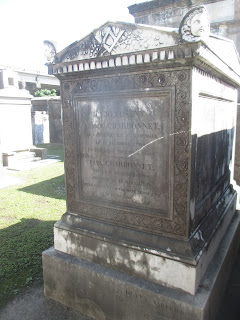The marble Paris made tomb of Ailmable Barthelemy CHARBONNET
also known as Amable CHARBONNET who was born in St. Jeremie, Ste. Domingue in 1790. Saint-Domingue (French pronunciation: [sɛ̃ dɔ.mɛ̃ɡ]) was a French colony on the Caribbean island of Hispaniola from 1659 to 1804. The French had established themselves on the western portion of the islands of Hispaniola and Tortuga by 1659. In the Treaty of Ryswick of 1697, Spain formally recognized French control of Tortuga island and the western third of the island of Hispaniola. Ailmable Barthelemy Charbonnet was 1st Sergeant Fourth Regiment (Morgan’s) Louisiana Militia - War of 1812
One of my favorite tombs in old New Orleans cemeteries is the Paris imported Tomb of Ailmable Barthelemy Charbonnet. & Emma Charbonnet .
Mostly because it is custom made and ordered from Paris. It's hard for us to imagine today but during the 19th century Creoles with money traveled to France offton for business, pleasure and family. Making a imported tomb like this in Creole New Orleans possible. The carved decorations on this Neoclassical tomb can tell use so much about Ailmable Barthelemy Charbonnet. One of the first things we see is at the top of the tomb is a Freemason Square and Compass letting us know Ailmable Barthelemy Charbonnet was a Freemason. On the corners of the tomb are winged angels letting us know Mr. Charbonnet was a Christian/Catholic. On the sides of the tomb we see the Catholic pelican-in-her-piety symbol.
The name of the Paris maker of this tomb is deeply inscribed on the lower right front, Duvey-Marbrier, Rue St. Andre, Popincourt No. 2. Fig. 24.
The corners of the toms showcase winged angels!
The Square and Compasses (or, more correctly, a square and a set of compasses joined together) is the single most identifiable symbol of Freemasonry.
depicted to the left of the compass is the letter "G" . The letter is interpreted to represent different words jurisdiction to jurisdiction. Among the most widely accepted interpretations are that: [G] stands for God, and is to remind Masons that God is at the center of Freemasonry. In this context it can also stand for Great Architect of the Universe (a reference to God). In a different context, the letter stands for Geometry, described as being the "noblest of sciences", and "the basis upon which the superstructure of Freemasonry is erected."
Also buried in the tomb is 7 year old Emma Charbonnet most likely the daughter of Ailmable Barthelemy CHARBONNET.
The name of the Paris maker of this tomb is deeply inscribed on the lower right front, Duvey-Marbrier, Rue St. Andre, Popincourt No. 2. Fig. 24.
According to legend, in a time of famine a mother pelican would draw blood from her own chest and give the blood to her chicks.
Thus the pelican symbol in Christianity, also called pelican-in-her-piety, symbolizes the sacrifice of Christ on the cross (because he gave his blood for others) as well as the Eucharist (because it represents Christ's blood and provides spiritual nourishment).
The legend of the pelican is an ancient one and had a few variations. It was adopted into Christianity by the 2nd century, when it appears in the Physiologus, a Christian adaptation of popular animal legends and symbols.
In medieval Europe, the pelican was thought to be particularly attentive to her young, to the point of providing her own blood by wounding her own breast when no other food was available. As a result, the pelican came to symbolise the Passion of Jesus and the Eucharist.
Details of the winged angels!
The back of the tomb has 3 stars.
The 3 stars could mean of or being a lieutenant general, as indicated by three stars on an insignia.
The side of the tomb
At the top is a ribbon with pelican-in-her-piety, with Freemason Square and Compass hanging from the ribbon.
The front tablet is surrounded by a beautifully carved Neoclassical rosette and scroll border.






































Loved reading this, Andrew. Made me think, too, what with mention of Saint-Domingue, New Orleans, and even France, that you might be interested in a post I did a while back:
ReplyDeletehttp://godsandfoolishgrandeur.blogspot.com/2015/11/a-member-of-family-rosalba-faure.html
The Gallien de Prévals, who lived in Saint-Domingue, and Cuba, then New Orleans are direct ancestors of my wife; Rosalba, her great-great-great-great-grandmother, married in France in 1831, but later returned for a time to New Orleans.
In the comments to this blog post a descendant of one of the slaves that Rosalba and the Gallien de Prévals "owned" contacted me. We've since compared notes about the two families and their tangled connections. And then, of course, you know so much about this period and so often share so much wonderful information.... : )
Thank you so much for making me aware of your post! I can't wait to read it. Anything about the past of New Orleans or France is of great interest to me!
ReplyDeleteThank you so much for making me aware of your post! I can't wait to read it. Anything about the past of New Orleans or France is of great interest to me!
ReplyDelete